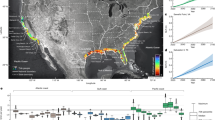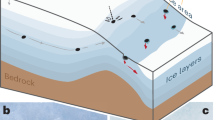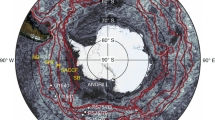Abstract
Recent centuries provide no precedent for the 2004 Indian Ocean tsunami, either on the coasts it devastated or within its source area. The tsunami claimed nearly all of its victims on shores that had gone 200 years or more without a tsunami disaster1. The associated earthquake of magnitude 9.2 defied a Sumatra–Andaman catalogue that contains no nineteenth-century or twentieth-century earthquake larger than magnitude 7.9 (ref. 2). The tsunami and the earthquake together resulted from a fault rupture 1,500 km long that expended centuries’ worth of plate convergence2,3,4,5. Here, using sedimentary evidence for tsunamis6, we identify probable precedents for the 2004 tsunami at a grassy beach-ridge plain 125 km north of Phuket. The 2004 tsunami, running 2 km across this plain, coated the ridges and intervening swales with a sheet of sand commonly 5–20 cm thick. The peaty soils of two marshy swales preserve the remains of several earlier sand sheets less than 2,800 years old. If responsible for the youngest of these pre-2004 sand sheets, the most recent full-size predecessor to the 2004 tsunami occurred about 550–700 years ago.
This is a preview of subscription content, access via your institution
Access options
Subscribe to this journal
Receive 51 print issues and online access
$199.00 per year
only $3.90 per issue
Buy this article
- Purchase on Springer Link
- Instant access to full article PDF
Prices may be subject to local taxes which are calculated during checkout



Similar content being viewed by others
References
Dominey-Howes, D., Cummins, P. & Burbidge, D. Historic records of teletsunami in the Indian Ocean and insights from numerical modeling. Nat. Hazards 42, 1–17 (2007)
Bilham, R., Engdahl, R., Feldl, N. & Satyabala, S. P. Partial and complete rupture of the Indo-Andaman Plate boundary 1847–2004. Seismol. Res. Lett. 76, 299–311 (2005)
Lovholt, F. et al. Earthquake related tsunami hazard along the western coast of Thailand. Nat. Hazards Earth Syst. Sci. 6, 979–997 (2006)
Stein, S. & Okal, E. A. Ultralong period seismic study of the December 2004 Indian Ocean earthquake and implications for regional tectonics and the subduction process. Bull. Seismol. Soc. Am. 97, S279–S295 (2007)
Chlieh, M. et al. Coseismic slip and afterslip of the great Mw 9.15 Sumatra-Andaman earthquake of 2004. Bull. Seismol. Soc. Am. 97, S152–S173 (2007)
Bourgeois, J. in The Sea Vol. 15 (eds Bernard, E. N. & Robinson, A. R.) (Harvard Univ. Press, in the press)
Tsuji, Y. et al. The 2004 Indian tsunami in Thailand; surveyed runup heights and tide gauge records. Earth Planets Space 58, 223–232 (2006)
Lyall, K. Out of the Blue: Facing the Tsunami (Australian Broadcasting Corporation, 2006)
Hori, K. et al. Horizontal and vertical variation of 2004 Indian tsunami deposits; an example of two transects along the western coast of Thailand. Mar. Geol. 239, 163–172 (2007)
Choowong, M. et al. 2004 Indian Ocean tsunami inflow and outflow at Phuket, Thailand. Mar. Geol. 248, 179–192 (2008)
Fujino, S. et al. in Tsunamiites—Features and Implications (eds Shiki, T., Tsuji, Y., Minoura, K. & Yamazaki, T.) 123–132 (Elsevier, 2008)
Fujino, S. et al. in Proc. Int. Symp. on Restoration Program from Giant Earthquakes and Tsunamis (ed. Kato, T.) 115–121 (Earthquake Research Institute, University of Tokyo, 2008)
Horton, B. P. et al. Holocene sea levels and palaeoenvironments, Malay-Thai Peninsula, Southeast Asia. Holocene 15, 1199–1213 (2005)
Hemphill-Haley, E. Diatoms as an aid in identifying late-Holocene tsunami deposits. Holocene 6, 439–448 (1996)
Kamatani, A. Dissolution rates of silica from diatoms decomposing at various temperatures. Mar. Biol. 68, 91–96 (1982)
Donnelly, J. P., Butler, J., Roll, S., Wengren, M. & Webb, T. A backbarrier overwash record of intense storms from Brigantine, New Jersey. Mar. Geol. 210, 107–121 (2004)
Gray, W. M. in Storms Vol. 1 (eds Pilke, R. J. & Pilke, R. S.) 145–163 (Routledge, 2000)
Pant, G. B. & Rupa Kumar, K. Climates of South Asia 320 (John Wiley & Sons, Chichester, England, 1997)
Murty, T. S. & Flather, R. A. Impact of storm surges in the Bay of Bengal. J. Coast. Res. 12 (Spec. Iss.). 149–161 (1994)
Monecke, K. et al. A 1,000-year sediment record of tsunami recurrence in northern Sumatra. Nature 10.1038/nature07374 (this issue)
Rajendran, K. et al. Age estimates of coastal terraces in the Andaman and Nicobar Islands and their tectonic implications. Tectonophysics 455, 53–60 (2008)
Ibn Battuta. The Travels of Ibn Battūta, A.D. 1325–1354 vol. 4 (transl. Gibb, H. A. R.) (Hakluyt Society, 1994)
Dreyer, E. L. Zheng He: China and the oceans in the early Ming dynasty 1405–1433 (Pearson Longman, 2007)
Okal, E. A. & Synolakis, C. E. Far-field tsunami hazard from mega-thrust earthquakes in the Indian Ocean. Geophys. J. Int. 172, 995–1015 (2008)
Heidarzadeh, M. et al. Historical tsunami in the Makran Subduction Zone off the southern coasts of Iran and Pakistan and results of numerical modeling. Ocean Eng. 35, 774–786 (2008)
Ortiz, M. & Bilham, R. Source area and rupture parameters of the 31 December 1881 M w = 7.9 Car Nicobar earthquake estimated from tsunamis recorded in the Bay of Bengal. J. Geophys. Res. 108 (B4) 2215 10.1029/2002JB001941 (2003)
Satake, K. et al. Tsunami heights and damage along the Myanmar coast from the December 2004 Sumatra–Andaman earthquake. Earth Planets Space 58, 243–252 (2006)
Siripong, A. Andaman seacoast of Thailand field survey after the December 2004 Indian Ocean tsunami. Earthq. Spectra 22, 187–202 (2006)
Choi, B. H. Analysis and modeling of the distribution functions of runup heights of the December 26, 2004 earthquake tsunami in the Indian Ocean. 〈http://wave.skku.ac.kr/tsunami_survey_data/KEERC.report.pdf〉
Hawkes, A. D. et al. Sediments deposited by the 2004 Indian Ocean tsunami along the Malaysia–Thailand Peninsula; Quaternary land–ocean interactions; sea-level change, sediments and tsunami. Mar. Geol. 242, 169–190 (2007)
Acknowledgements
We thank B. Korsakun for logistical help; C. Tongjeen for permission for digging; V. Chutakositkanon, V. Jittanoon, T. Machado, T. Napradit, S. Pailoplee, S. Phantuwongraj, N. Rajeshwara Rao, S. Srinivasalu, P. Surakiatchai and A. Weerahong for contributions to Phra Thong field and laboratory work; Y. Fujii for providing bathymetric data; and S. Bondevik, M. Cisternas, H. Kelsey, A. Meltzner, K. Sieh, M. Tuttle and J. Woodruff for reviews. This report evolved from surveys supported by the Ministry of Natural Resources and Environment (Thailand), the National Science Foundation (USA), and the US Agency for International Development (participants are listed in Supplementary Table 3). Additional funding was provided by the Japan Society for the Promotion of Science (to Y.S.), the Thailand Research Fund (to M.C.), and Chulalongkorn University (through P. Charusiri).
Author Contributions All authors participated in the fieldwork, led by K.J. (Supplementary Table 1). B.A. prepared most of the manuscript. Y.S. analysed the diatoms and prepared several of the figures.
Author information
Authors and Affiliations
Corresponding author
Supplementary information
Supplementary Information
This file contains Supplementary Figures S1-S7 with Legends and Supplementary Tables S1-S3 (PDF 4776 kb)
Rights and permissions
About this article
Cite this article
Jankaew, K., Atwater, B., Sawai, Y. et al. Medieval forewarning of the 2004 Indian Ocean tsunami in Thailand. Nature 455, 1228–1231 (2008). https://doi.org/10.1038/nature07373
Received:
Accepted:
Issue Date:
DOI: https://doi.org/10.1038/nature07373
This article is cited by
-
Marine inundation history during the last 3000 years at Lake Kogare-ike, a coastal lake on the Pacific coast of central Japan
Progress in Earth and Planetary Science (2023)
-
Sedimentary diversity of the 2011 Tohoku-oki tsunami deposits on the Sendai coastal plain and the northern coast of Fukushima Prefecture, Japan
Progress in Earth and Planetary Science (2023)
-
Scour ponds from unusually large tsunamis on a beach-ridge plain in eastern Hokkaido, Japan
Scientific Reports (2023)
-
The use of magnetic and geoelectrical methods to locate buried ancient artificial canals and wells around the cultural heritage of Indrapatra Fort, Aceh, Indonesia
Geosciences Journal (2023)
-
Identifying tsunami traces beyond sandy tsunami deposits using terrigenous biomarkers: a case study of the 2011 Tohoku-oki tsunami in a coastal pine forest, northern Japan
Progress in Earth and Planetary Science (2022)
Comments
By submitting a comment you agree to abide by our Terms and Community Guidelines. If you find something abusive or that does not comply with our terms or guidelines please flag it as inappropriate.



